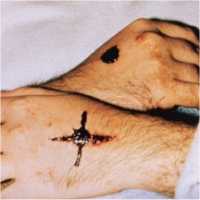Stigmas indicate their carriers are either saints or insane
For over 750 years already some Christians have stigmata on their bodies as symbols of Christ's sufferings
The hands and legs of the Savior were punched through with nails. The crown of thorns on his head scratched the forehead and the skull. One of the Roman legionaries deeply wounded the Savior with his spear right in the chest.

For over 750 years already some Christians have stigmata on their bodies as symbols of Christ's sufferings. The Greek word 'stigma' means 'wound.' Stigmata may look like bleeding wounds on palms or on feet as if people were nailed down. Some people having stigmata have wounds on their foreheads resembling scratches left by a crown of thorns. Others have bloody wales on their backs as if traces of flagellation.
Saint Francis of Assisi is believed the first man who ever had stigma. It was in 1224 that stigma appeared on the man during the holiday of Exaltation of the Cross. A legend says that Saint Francis had a vision of an angel who excised the stigmata on the saint's hands and legs with five rays of light. 
However, some experts insist that the first evidence of stigma belongs to an earlier epoch, the first years of Christianity. One of Saint Paul's messages mentions that after the crucifixion of Christ Saint Paul got wounds like those that Christ had. The statement can be interpreted either literally or metaphorically. But it is true that no more evidence of stigma appeared within about a thousand of years afterwards.
There are some versions explaining why stigmata began to appear at the beginning of the current century. The first version says stigma appeared because of the intensified theological disputes in the 11-12th centuries. When Christianity split into the Catholic and Orthodox churches in 1054, Catholics proclaimed the Resurrection doctrine. Then theologians developed the ideas of Christ's human nature. A new religious holiday of Corp Christi was established to memorize the corporal life of Christ from Christmas to Crucifixion. The first evidence of stigma belongs to the period.
Another theory explains the appearance of stigma with the general tension and expressiveness of the church art of that epoch. Naturalistic bloody scenes of the Passion were in fashion and greatly excited the faithful. One more version says that many people considered the church too corrupt. The appearance of stigma strengthened laymen's opinion that Christ is the only shepherd of his herd; it also gave the faithful an immediate contact with Corp Christi.
French doctor Amber-Gourbet described about 300 instances of stigmatism in the 19th century that were based upon historical records and contemporary evidence. But today majority of his reports are declared unauthentic. Contemporary experts state that there were 406 of relatively authentic instances of stigma appearance within the past800years. Majority of stigma carriers were Catholics (68 percent) and others belonged to different religious sects.
Earlier, stigmata were typical of Mediterranean citizens, mainly Italians. Today stigma is also typical of Japans, Koreans; at least four Americans, an Argentinean and a Canadian are known as stigma carriers.
Thousands of people believe that stigma is the charisma. But one of theosophy schools states that stigma is Satan's sign. The official Vatican is rather cautious concerning appearance of stigma. The traditional procedure of canonization of a stigmatic requires that it may happen in about one hundred of years after his death. Clergymen and medical experts appointed by Vatican closely study every instance of stigma appearance. The church admits that stigma may mysteriously appear on people. But church experts believe that psychiatrists should study majority of stigma instances. Many of stigma carriers reveal hysteria quite obviously. In some cases stigma carriers revealed various clinical syndromes, inclination to self-torture and extremely low self-appraisal. There are also stigma carriers who say their wounds appeared as a result of contacts with aliens.
It is not ruled out that mentally unstable people may make wounds themselves. But stigma appearance is in fact a more complicated phenomenon. Majority of people carrying stigmata do not remembers when and how they got their wounds. There is much evidence proving that no matter what medical treatment is applied to the mysterious wounds, they will re-appear in the same area. Italian Doctor Marco Marnelli conducted several experiments on a woman carrying stigma. The experiments revealed the healed stigma re-appeared on the woman's hands several times. At that, each time the stigma became visible on the body the woman fell into a trance and saw beads and a cross. American Ethel Chapman got her stigma resembling nail wounds on the palms when she was in a hospital. When unconscious the woman observed her own crucifixion.
The faithful usually treat stigma carriers as God's elects. This opinion is as a rule substantiated with stories about the ability of some stigma carriers to levitate or about some wonderful aroma spreading from wounds of such people. As a rule, the nature of these phenomena is quite explainable.
Both secular and church experts say there may be no well-defined approach to the stigma phenomena. Majority of stigmata are quite of common origin but there is no rational explanation to many of stigmatism instances. This is a complicated phenomenon where physical, psychosomatic and supernatural motives are combined. The phenomenon will be probably explained some day. For the time being, people believe in the mysterious nature of stigmata.
Discuss this article on Pravda.Ru English Forum
Subscribe to Pravda.Ru Telegram channel, Facebook, RSS!


